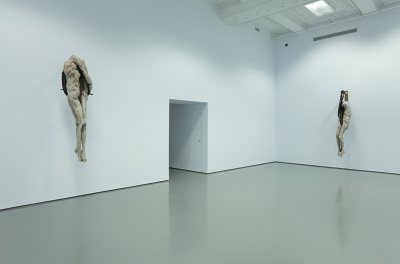If Eyes Are Windows…
If Eyes Are Windows…
If eyes are windows to the soul, then some of John Currin’s depictions of women beg the question: where are these poor souls?
Portraits generally aim to capture a person’s character through their facial features, their position and posture, elements in the background, and most importantly, through their eyes. A strange thing occurs, however, in some of Currin’s depiction of women. The characters (or caricatures?) are at times depicted with eyes that are black, vacant, and seemingly soulless. They stare out at the viewer blankly in an unsure, nervous and sometimes slightly deranged manner (for example, in Old Couple).
The viewer is unable to really connect to the characters, as there is no substance in the eyes. Indeed, in works such as Bea Arthur Naked, Ms. Omni, andBrown Lady, the women’s eyes seem to be as monotone and empty as the neutral backgrounds in which they are presented.
Currin does give us a point of entry into some of his protagonists’ eyes. Girl in Bed depicts a young girl who is lying down, with eyes staring off into the distance. Her body is motionless, but her gaze hints at an active mind.
In Honeymoon Nude, the character’s eyes are illuminated and bright…although she appears to have more of a doll’s gaze than that of a thinking, feeling human being.
In Rachel in Fur, the eyes are hidden behind large, dark sunglasses. By peeking behind the lenses, we can glimpse a sideways glance as the protagonist stares off into to the lower right side of the painting. She seems less confident than the fur and gold would suggest – like a child dressing up in her mother’s clothing, donning over-sized sunglasses for a seemingly glamorous last touch.
Interestingly, while the lack of details in the eyes of Currin’s characters creates a separation between “us” as viewers and “them” as being viewed, the absence of facial features (and, in fact, the absence of faces at all) in Berlinde De Bruyckere’s sculptural works somehow unites us to them. Sharing the same space as Invisible Love Invisible Beauty I and II, the viewer is immediately drawn into their states of being, of mind, of suffering. The bodies speak volumes louder than an individual face could.

The reaction that one has to De Bruyckere’s work is innately visceral, physical, and immediate. There is no need to gaze into the eyes of an individual being to understand. Perhaps it is not even about the individual, and more about a universal feeling: the turmoil and torment, the physical abuse, the hardships that human beings can endure. This goes above and beyond the stories that can be read through the expression in one’s eyes. This is the story of beings as entire universes, as complex as they are beautiful and horrible.
The gaze is a powerful tool. In Currin’s work, the presence or absence of the character seems to reside in the detail of their eyes. The connection that the viewer can forge with these painted personas depends on the level to which we are able to read them through their eyes. De Bruyckere demonstrates that while the gaze may be powerful, the body is deafening. Commanding more emotion and compassion than a simple wink of an eye, it is the body in De Bruyckere’s work that provides a window to the soul – a window that has been broken and shattered, and that requires some mending if it is to continue in its role of protection and shelter from the raging storms outside.
Amanda Beattie
DHC/ART Education
This text reflects the point of view of the author and not that of DHC/ART.
Photos:
John Currin, Rachel in fur, 2002. Courtesy Gagosian Gallery.
Berlinde de Bruyckere, Invisible beauty and invisible love I & II, 2011, photo: Richard-Max Tremblay.